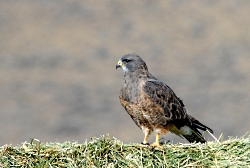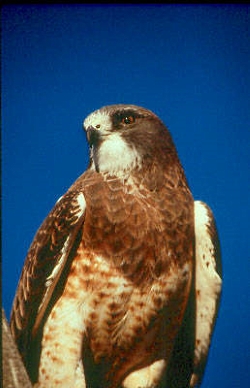
Photo Courtesy US FWS
 Swainson’s Hawk, (Buteo swainsoni)
Swainson’s Hawk, (Buteo swainsoni)Photo Courtesy US FWS
The Wellsville Mountains of N. Utah are known for their steepness, spectacular beauty, and an extraordinary fall raptor migration. The perfect mix of thermal uplift on its west slopes funnels the birds along the east side of the Great Salt Lake to their southerly destinations. Many species- eagles, falcons, accipiter’s, and buteos grace its slopes. The migration occurs primarily from mid-August to mid-October. Last Saturday’s hawk watchers were treated to 300 plus birds consisting of 15 species.
There is one in particular that is known for its extraordinary abilities and unusual behaviors that I will dwell on, that being the Swainson’s hawk. Nearly the entire population of these amazing birds will navigate their way to Argentina, a distance not equaled by any other raptor.
This species was named after William Swainson, a British naturalist. It is also known as the grasshopper hawk or locust hawk, as it is very fond of locusts and grasshoppers and will voraciously eat these insects whenever they are available. They have the unusual behavior of congregating in large numbers in fields to attack their prey. I’ve counted over 100 birds occupying cut hay fields in a half mile distance.
Breeding Swainson’s hawks are opportunistic feeders that respond quickly to local concentrations of food and rely heavily upon small mammal, bird, and reptiles such as young ground squirrels, rabbits, pocket gophers, mice, small birds. Birds taken include Mallards, young Sage Grouse, American kestrel, and young short-eared owls. Reptiles include snakes such as racers, gophers, striped whipsnakes, and lizards. Amphibians include tiger salamanders and toads.
In Argentina, Swainson’s hawks feed on flocks of the migratory darner dragonfly, following the hordes of insects and feeding mostly on the wing. Local outbreaks of locusts may also be exploited. There is also some evidence that road-killed birds and animals are consumed both on the wintering grounds and on the breeding grounds. They commonly follow tractors during haying or ploughing, where rodents are exposed for the hawks to capture, or insects are uncovered after crop cutting.
Wildfires often attract foraging hawks, especially grass fires in their South American wintering range where they frequently wait around the edges of the fire, picking off insects and vertebrates including grouse, lizards, and snakes.
This weekend I will be on my way to our raptor observation peak high in the Wellsvilles hoping to see this amazing bird, along with a host of other raptors as they migrate to more favorable climes, but only one of the myriad species will make it all the way to Argentina!
This is Jack Greene reading for Wild About Utah.
Credits:
Pictures: Courtesy US FWS, San Andres NWR
Text: Jack Greene, Bridgerland Audubon Society
Additional Reading:
Animal Fact Sheet: Ringtail, Arizona-Sonora Desert Museum, https://www.desertmuseum.org/kids/oz/long-fact-sheets/Ringtail.php
Ringtail (Bassariscus astutus), Wildscreen Arkive, https://www.arkive.org/ringtail/bassariscus-astutus/
